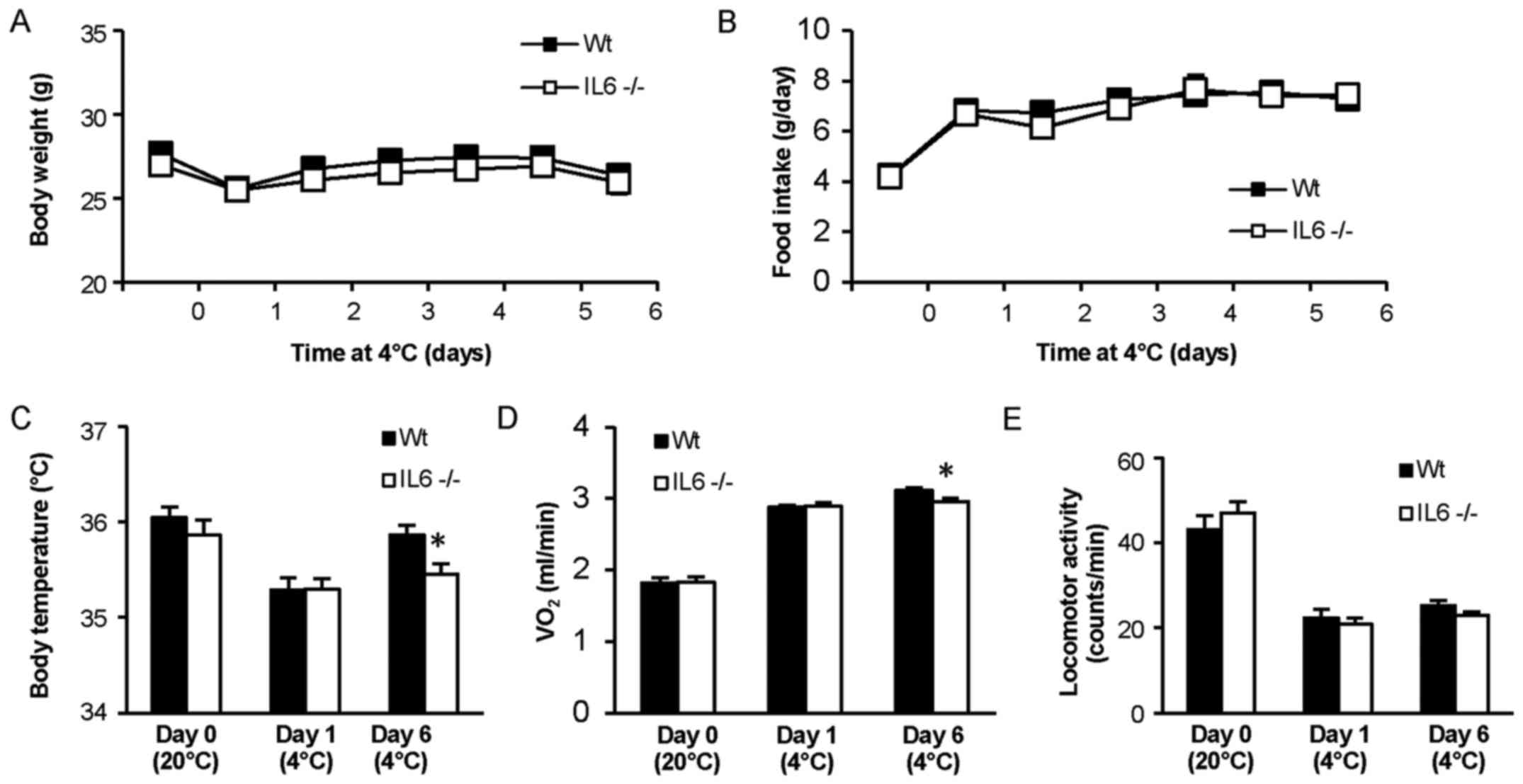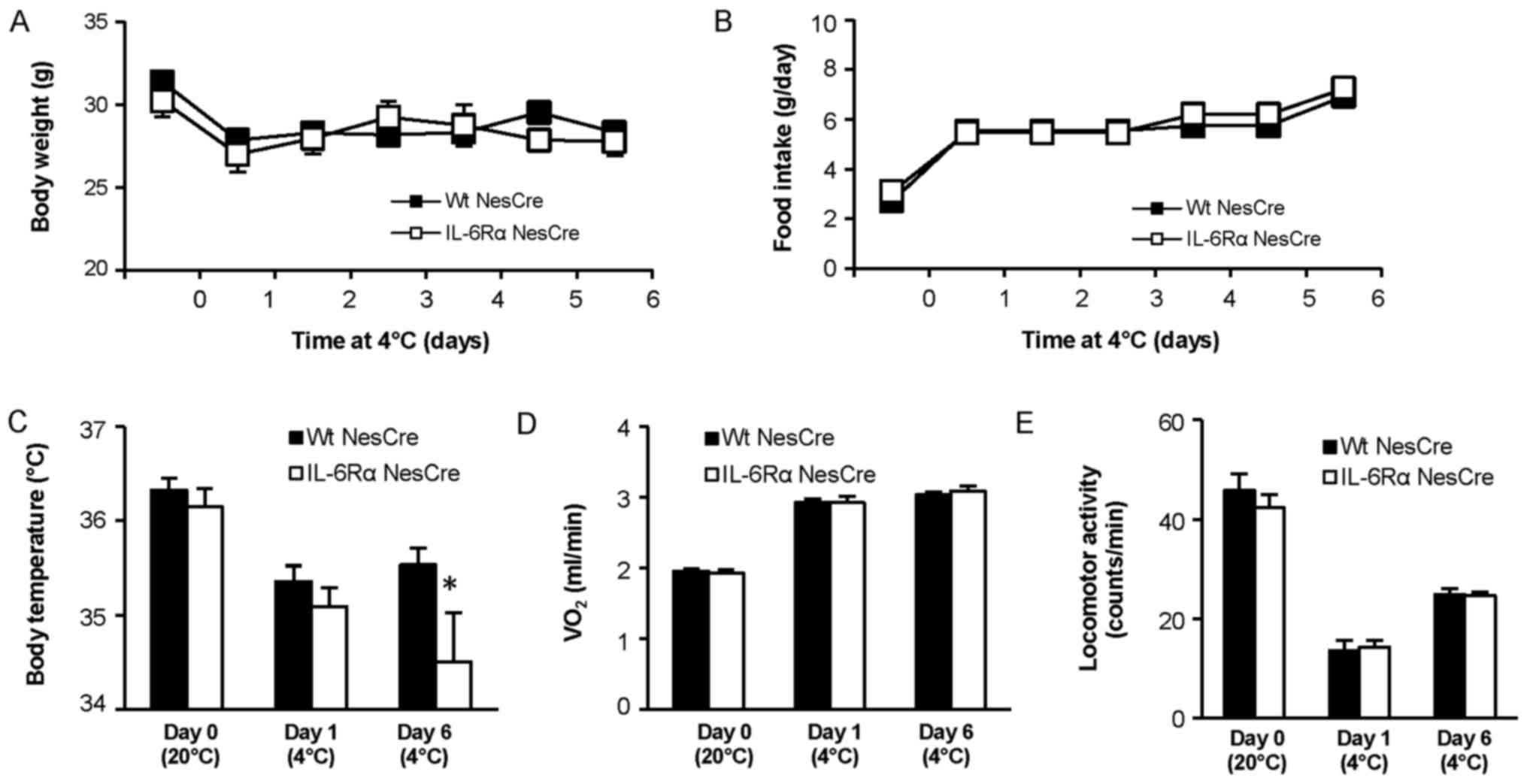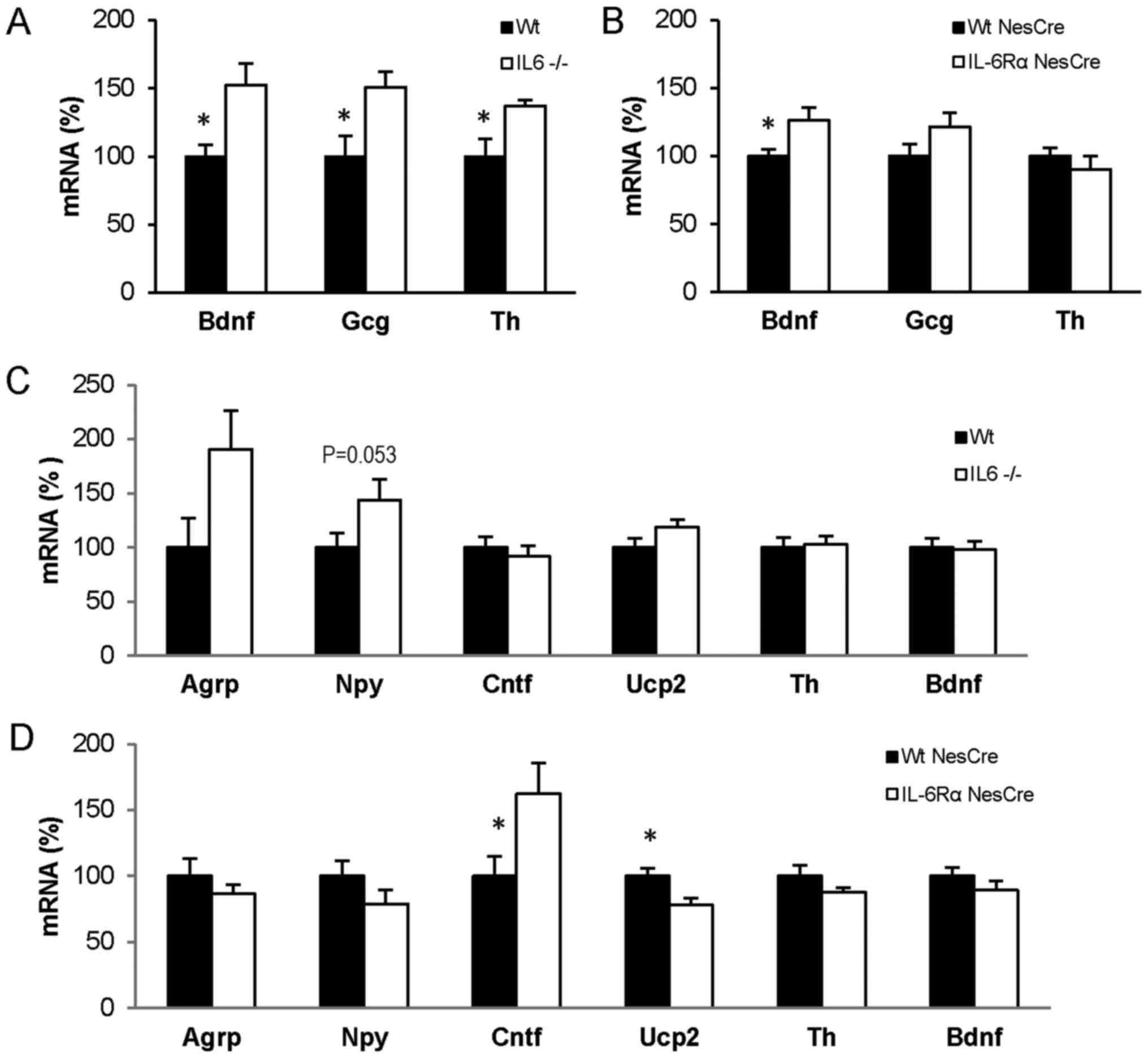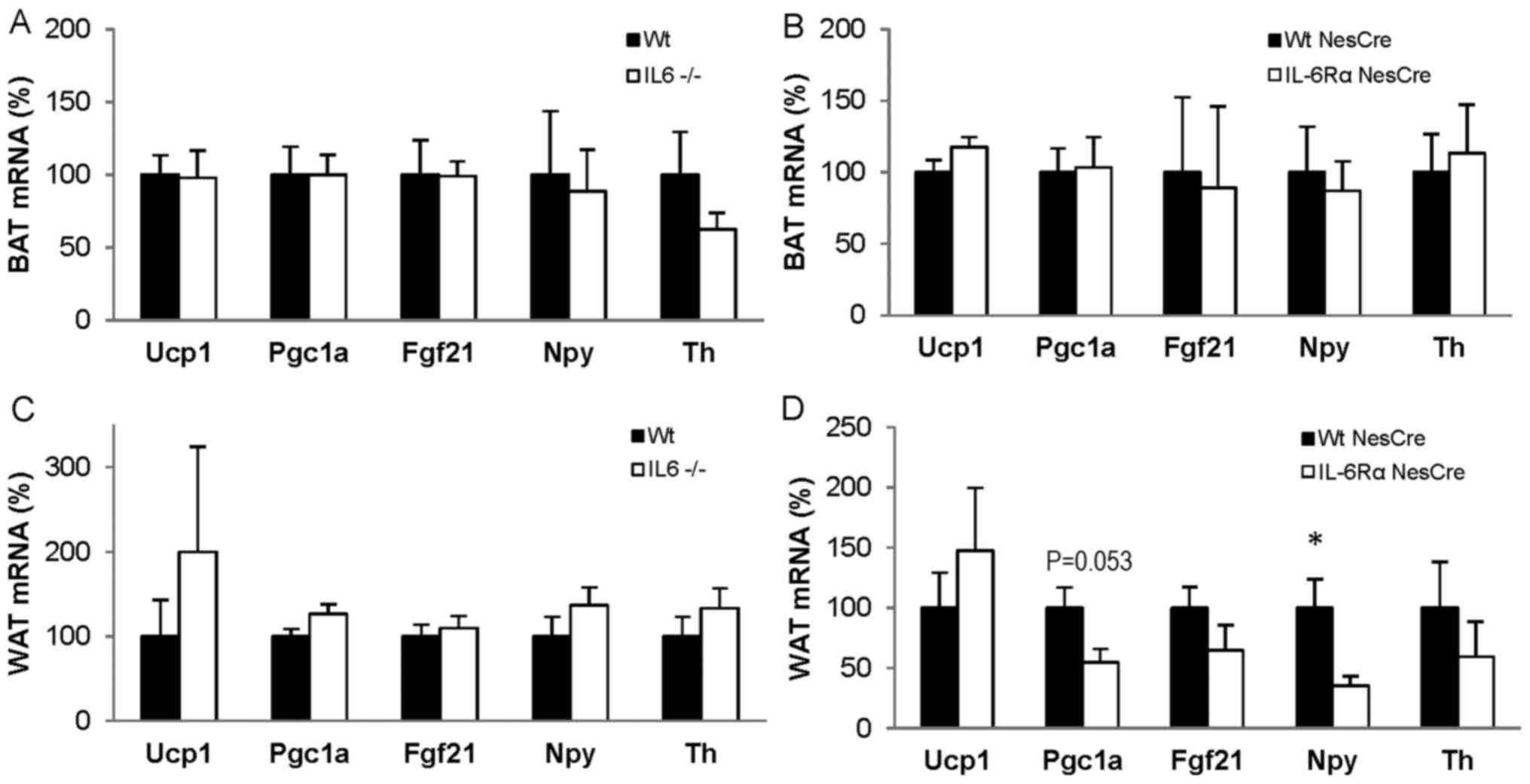|
1
|
Luheshi GN: Cytokines and fever.
Mechanisms and sites of action. Ann N Y Acad Sci. 856:83–89. 1998.
View Article : Google Scholar : PubMed/NCBI
|
|
2
|
Leon LR: Invited review: cytokine
regulation of fever: studies using gene knockout mice. J Appl
Physiol 1985. 92:2648–2655. 2002. View Article : Google Scholar : PubMed/NCBI
|
|
3
|
Sundgren-Andersson AK, Ostlund P and
Bartfai T: IL-6 is essential in TNF-alpha-induced fever. Am J
Physiol. 275:R2028–R2034. 1998.PubMed/NCBI
|
|
4
|
Zetterström M, Sundgren-Andersson AK,
Ostlund P and Bartfai T: Delineation of the proinflammatory
cytokine cascade in fever induction. Ann N Y Acad Sci. 856:48–52.
1998. View Article : Google Scholar : PubMed/NCBI
|
|
5
|
Morrison SF and Nakamura K: Central neural
pathways for thermoregulation. Front Biosci. 16:74–104. 2011.
View Article : Google Scholar
|
|
6
|
Nguyen KD, Qiu Y, Cui X, Goh YP, Mwangi J,
David T, Mukundan L, Brombacher F, Locksley RM and Chawla A:
Alternatively activated macrophages produce catecholamines to
sustain adaptive thermogenesis. Nature. 480:104–108. 2011.
View Article : Google Scholar : PubMed/NCBI
|
|
7
|
Qiu Y, Nguyen KD, Odegaard JI, Cui X, Tian
X, Locksley RM, Palmiter RD and Chawla A: Eosinophils and type 2
cytokine signaling in macrophages orchestrate development of
functional beige fat. Cell. 157:1292–1308. 2014. View Article : Google Scholar : PubMed/NCBI
|
|
8
|
Cannon B and Nedergaard J: Brown adipose
tissue: Function and physiological significance. Physiol Rev.
84:277–359. 2004. View Article : Google Scholar : PubMed/NCBI
|
|
9
|
Bal NC, Maurya SK, Pani S, Sethy C,
Banerjee A, Das S, Patnaik S and Kundu CN: Mild cold induced
thermogenesis: Are BAT and skeletal muscle synergistic partners?
Biosci Rep. 37:BSR201710872017. View Article : Google Scholar : PubMed/NCBI
|
|
10
|
Wernstedt I, Edgley A, Berndtsson A, Fäldt
J, Bergström G, Wallenius V and Jansson JO: Reduced stress- and
cold-induced increase in energy expenditure in
interleukin-6-deficient mice. Am J Physiol Regul Integr Comp
Physiol. 291:R551–R557. 2006. View Article : Google Scholar : PubMed/NCBI
|
|
11
|
Cannon B and Nedergaard J: Nonshivering
thermogenesis and its adequate measurement in metabolic studies. J
Exp Biol. 214:242–253. 2011. View Article : Google Scholar : PubMed/NCBI
|
|
12
|
Knudsen JG, Murholm M, Carey AL, Biensø
RS, Basse AL, Allen TL, Hidalgo J, Kingwell BA, Febbraio MA, Hansen
JB, et al: Role of IL-6 in exercise training- and cold-induced UCP1
expression in subcutaneous white adipose tissue. PLoS One.
9:e849102014. View Article : Google Scholar : PubMed/NCBI
|
|
13
|
Reichardt HM, Kellendonk C, Tronche F and
Schütz G: The Cre/loxP system-a versatile tool to study
glucocorticoid signalling in mice. Biochem Soc Trans. 27:78–83.
1999. View Article : Google Scholar : PubMed/NCBI
|
|
14
|
Directive 2010/63/EU of the European
Parliament and of the Council of 22 September 2010 on the
protection of animals used for scientific purposes. OJ L.
276:33–79. 2010.
|
|
15
|
Livak KJ and Schmittgen TD: Analysis of
relative gene expression data using real-time quantitative PCR and
the 2(-Delta Delta C(T)) Method. Methods. 25:402–408. 2001.
View Article : Google Scholar : PubMed/NCBI
|
|
16
|
Rowland LA, Bal NC and Periasamy M: The
role of skeletal-muscle-based thermogenic mechanisms in vertebrate
endothermy. Biol Rev Camb Philos Soc. 90:1279–1297. 2015.
View Article : Google Scholar : PubMed/NCBI
|
|
17
|
Morrison SF, Nakamura K and Madden CJ:
Central control of thermogenesis in mammals. Exp Physiol.
93:773–797. 2008. View Article : Google Scholar : PubMed/NCBI
|
|
18
|
Pant M, Bal NC and Periasamy M:
Sarcolipin: A key thermogenic and metabolic regulator in skeletal
muscle. Trends Endocrinol Metab. 27:881–892. 2016. View Article : Google Scholar : PubMed/NCBI
|
|
19
|
Bal NC, Maurya SK, Singh S, Wehrens XH and
Periasamy M: Increased reliance on muscle-based thermogenesis upon
acute minimization of brown adipose tissue function. J Biol Chem.
291:17247–17257. 2016. View Article : Google Scholar : PubMed/NCBI
|
|
20
|
Jonsdottir IH, Schjerling P, Ostrowski K,
Asp S, Richter EA and Pedersen BK: Muscle contractions induce
interleukin-6 mRNA production in rat skeletal muscles. J Physiol.
528:157–163. 2000. View Article : Google Scholar : PubMed/NCBI
|
|
21
|
Wallenius V, Wallenius K, Ahrén B, Rudling
M, Carlsten H, Dickson SL, Ohlsson C and Jansson JO:
Interleukin-6-deficient mice develop mature-onset obesity. Nat Med.
8:75–79. 2002. View Article : Google Scholar : PubMed/NCBI
|
|
22
|
Rowland LA, Bal NC, Kozak LP and Periasamy
M: Uncoupling protein 1 and sarcolipin are required to maintain
optimal thermogenesis, and loss of both systems compromises
survival of mice under cold stress. J Biol Chem. 290:12282–12289.
2015. View Article : Google Scholar : PubMed/NCBI
|
|
23
|
Spaeth AM, Kanoski SE, Hayes MR and Grill
HJ: TrkB receptor signaling in the nucleus tractus solitarius
mediates the food intake-suppressive effects of hindbrain BDNF and
leptin. Am J Physiol Endocrinol Metab. 302:E1252–E1260. 2012.
View Article : Google Scholar : PubMed/NCBI
|
|
24
|
An JJ, Liao GY, Kinney CE, Sahibzada N and
Xu B: Discrete BDNF neurons in the paraventricular hypothalamus
control feeding and energy expenditure. Cell Metab. 22:175–188.
2015. View Article : Google Scholar : PubMed/NCBI
|
|
25
|
Larsen PJ, Tang-Christensen M, Holst JJ
and Orskov C: Distribution of glucagon-like peptide-1 and other
preproglucagon-derived peptides in the rat hypothalamus and
brainstem. Neuroscience. 77:257–270. 1997. View Article : Google Scholar : PubMed/NCBI
|
|
26
|
Beiroa D, Imbernon M, Gallego R, Senra A,
Herranz D, Villarroya F, Serrano M, Fernø J, Salvador J, Escalada
J, et al: GLP-1 agonism stimulates brown adipose tissue
thermogenesis and browning through hypothalamic AMPK. Diabetes.
63:3346–3358. 2014. View Article : Google Scholar : PubMed/NCBI
|
|
27
|
Lockie SH, Heppner KM, Chaudhary N,
Chabenne JR, Morgan DA, Veyrat-Durebex C, Ananthakrishnan G,
Rohner-Jeanrenaud F, Drucker DJ, DiMarchi R, et al: Direct control
of brown adipose tissue thermogenesis by central nervous system
glucagon-like peptide-1 receptor signaling. Diabetes. 61:2753–2762.
2012. View Article : Google Scholar : PubMed/NCBI
|
|
28
|
Kooijman S, Wang Y, Parlevliet ET, Boon
MR, Edelschaap D, Snaterse G, Pijl H, Romijn JA and Rensen PC:
Central GLP-1 receptor signalling accelerates plasma clearance of
triacylglycerol and glucose by activating brown adipose tissue in
mice. Diabetologia. 58:2637–2646. 2015. View Article : Google Scholar : PubMed/NCBI
|
|
29
|
Stefater MA, MacLennan AJ, Lee N,
Patterson CM, Haller A, Sorrell J, Myers M, Woods SC and Seeley RJ:
The anorectic effect of CNTF does not require action in
leptin-responsive neurons. Endocrinology. 153:2647–2654. 2012.
View Article : Google Scholar : PubMed/NCBI
|
|
30
|
Conti B, Sanchez-Alavez M, Winsky-Sommerer
R, Morale MC, Lucero J, Brownell S, Fabre V, Huitron-Resendiz S,
Henriksen S, Zorrilla EP, et al: Transgenic mice with a reduced
core body temperature have an increased life span. Science.
314:825–828. 2006. View Article : Google Scholar : PubMed/NCBI
|
|
31
|
Coppola A, Liu ZW, Andrews ZB, Paradis E,
Roy MC, Friedman JM, Ricquier D, Richard D, Horvath TL, Gao XB, et
al: A central thermogenic-like mechanism in feeding regulation: An
interplay between arcuate nucleus T3 and UCP2. Cell Metab. 5:21–33.
2007. View Article : Google Scholar : PubMed/NCBI
|
|
32
|
Schéle E, Benrick A, Grahnemo L, Egecioglu
E, Anesten F, Pálsdóttir V and Jansson JO: Inter-relation between
interleukin (IL)-1, IL-6 and body fat regulating circuits of the
hypothalamic arcuate nucleus. J Neuroendocrinol. 25:580–589. 2013.
View Article : Google Scholar : PubMed/NCBI
|
|
33
|
Shi YC, Lau J, Lin Z, Zhang H, Zhai L,
Sperk G, Heilbronn R, Mietzsch M, Weger S, Huang XF, et al: Arcuate
NPY controls sympathetic output and BAT function via a relay of
tyrosine hydroxylase neurons in the PVN. Cell Metab. 17:236–248.
2013. View Article : Google Scholar : PubMed/NCBI
|
|
34
|
Bal NC, Singh S, Reis FCG, Maurya SK, Pani
S, Rowland LA and Periasamy M: Both brown adipose tissue and
skeletal muscle thermogenesis processes are activated during mild
to severe cold adaptation in mice. J Biol Chem. 292:16616–16625.
2017. View Article : Google Scholar : PubMed/NCBI
|
|
35
|
Nedergaard J and Cannon B: The browning of
white adipose tissue: Some burning issues. Cell Metab. 20:396–407.
2014. View Article : Google Scholar : PubMed/NCBI
|
|
36
|
Jankovic A, Golic I, Markelic M, Stancic
A, Otasevic V, Buzadzic B, Korac A and Korac B: Two key temporally
distinguishable molecular and cellular components of white adipose
tissue browning during cold acclimation. J Physiol. 593:3267–3280.
2015. View Article : Google Scholar : PubMed/NCBI
|
|
37
|
Li G, Klein RL, Matheny M, King MA, Meyer
EM and Scarpace PJ: Induction of uncoupling protein 1 by central
interleukin-6 gene delivery is dependent on sympathetic innervation
of brown adipose tissue and underlies one mechanism of body weight
reduction in rats. Neuroscience. 115:879–889. 2002. View Article : Google Scholar : PubMed/NCBI
|


















